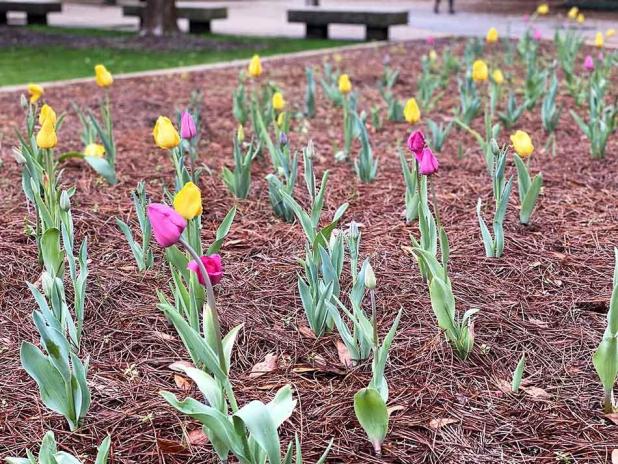
Pine straw mulch is a great choice for ornamental landscape beds and for vegetable beds.
—LSU AgCenter/Heather Kirk-Ballard
Get it Growing: Mulch has many benefits
Mulching is one of the most basic and essential tasks of gardening. Most of us mulch because it helps reduce the amount of time we spend pulling weeds.
Mulch provides many other benefits, however. It helps maintain soil moisture and reduces the amount of water lost to evaporation — which decreases the amount of time we spend watering and the amount of water we use.
Mulch also helps buffer the soil temperature by trapping radiant heat from the soil in the winter and insulating roots from the heat of the summer. Aesthetically, it provides a neat and uniform appearance to landscape beds.
It’s a good practice to check mulched areas every spring and fall as part of your routine gardening maintenance. Check for thinned areas that need to be replenished with fresh material.
The best depth for a mulch layer is 2-4 inches. Too thick a layer can reduce oxygen reaching the soil. Too thin, and you give weeds a fighting chance.
There are two main types of mulch: organic and inorganic. Natural, organic mulches include wood chips, shredded bark, pine needles, leaves, compost, straw, grass clippings, and even paper or cardboard. Inorganic mulches can be rocks, plastic mulches and landscape fabrics.
One additional benefit of organic mulches is that as they decompose, they improve soil fertility, aeration, structure and even drainage. All of these will improve plant growth and health. Major bonus!
Each type of mulch material offers benefits — and sometimes, drawbacks. What you choose ultimately depends on the design, intended use of the area and the types of plants growing there.
Bark mulches are one of the most commonly used, readily available and often the least expensive. Available in larger nuggets or shredded, they come from several types of trees, including pine, cedar and cypress.
When weighing the benefits of bark nuggets vs. shredded, be aware that nuggets break down much slower but do not stay in place well. Heavy rains can carry them away, and if not layered at a good depth, they leave large gaps where weeds can grow. Shredded bark provides good coverage and stays in place well, but breaks down more quickly than nuggets.
When choosing the tree source from which the mulch is made, please seriously consider avoiding the use of cypress. Mulches made from bald or pond cypress are not as sustainable or environmentally friendly as other types. The harvesting of cypress trees can increase the loss of coastal wetlands and wildlife habitat — a situation we are desperately trying to stop.
Bark mulches are great for landscape beds, but are not recommended for vegetable gardens because they can tie up nitrogen from the soil, making it less available to the plants. However, leaves, pine needles and straw are ideal for vegetable gardens.
Straw mulches, including pine needles, are excellent choices for both vegetable and ornamental landscape beds. They have the benefit of slower breakdown than leaves or grass clippings, and you can find them in small, shredded options in addition to larger sizes. They are readily available and affordable. Both help prevent soil from splashing up onto fruits and vegetables when laid properly.
Fallen leaves are economical because they are free. You’ve got to get them cleaned up, so why not put them to work for you? Additionally, it is a sustainable landscape practice to use fallen leaves as mulch or to make compost. They may not be as uniform and aesthetically pleasing — but practicality goes farther than beauty in my book.
One other organic option is paper and cardboard. Place a thick layer down and use a few rocks to hold in place, or cover it with a thin layer of another type of organic mulch. Voila — you are reusing and reducing waste! Paper will eventually break down. Paper mulch rolls also are being produced now. They can be purchased available online and sometimes in stores.
Inorganic options are landscape fabric and plastic mulches. They can be very effective, especially when growing vegetables and in rows. They are readily available, but are often more expensive and labor intensive to install. They do a great job of suppressing weeds, retaining moisture and preventing soil from splashing up onto plants. But black plastic mulches get very hot during the summertime, take time to pull up and are persistent, meaning they don’t break down and are not environmentally friendly.
Rocks also can be used as an inorganic mulch. They don’t break down, so you won’t have to reapply, but they do not improve your soil and they can get very hot in the summer. If they are not laid thickly enough, they allow weed growth.
You will likely need to use a landscape fabric underneath rocks to help prevent weeds, making this one of the most expensive options. However, rocks are uniform and add aesthetic interest to the landscape.
